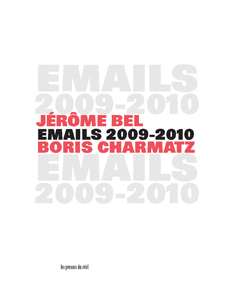The two dancers and choreographers share and compare ideas and references that underpin their respective work.
In 2009, the Paris Autumn Festival and Le Théâtre de la Ville celebrated the work of Merce Cunningham. On this occasion, Jérôme Bel's Cédric Andrieux and Boris Charmatz's 50 ans de danse were presented to the audience.
The two artists were also asked to engage in a conversation on Merce Cunningham. The conversation soon extended in a one-year email exchange in which Jérôme Bel and Boris Charmatz shared the conceptions and references at the heart of their respective artistic work. Conceived as a comparative study, the discussion reveals the artists' common features and differences on dance and choreography.
Dancer and choreographer Jérôme Bel lives in Paris, he works worldwide. His first piece, a choreography of objects, is entitled
name given by the author (1994). The second one, Jerome Bel (1995), is based on the identity and the total nudity of the four performers. The third one,
Shirtology (1997) presents an actor wearing many shop-bought T-shirts.
The last performance (1998), which in quoting several times a solo by the German choreographer Susanne Linke, and also Hamlet or André Agassi, tries to define an ontology of the performance. The piece
Xavier Le Roy (2000) was claimed by Jérôme Bel as his own, but was actually made by the choreographer
Xavier Le Roy.
The show must go on (2001) brings toghether a cast of twenty performers, nineteen pop songs and one DJ. In 2004, he was invited to produce a piece for the Paris Opera ballet:
Veronique Doisneau (2004), a theatrical documentary on the work of the dancer Véronique Doisneau, from the ballet corps of that company.
Isabel Torres (2005) for the ballet of the Teatro Municipal of Rio de Janeiro is the Brazilian version of the production for the Paris Opera.
Pichet Klunchun and myself (2005) is created in Bangkok with the Thai traditional dancer Pichet Klunchun. In 2009, he produces
Cédric Andrieux (2009), dancer in the Merce Cunningham Dance Company and then at the Lyon Opera Ballet. In 2010, he creates with Anne Teresa De Keersmaeker
3Abschied (2010), a performance based on
The song of the Earth by Gustav Malher. In 2012, he produces
Disabled Theater (2012), a piece with a Zurich-based company, Theater Hora, consisting of professional actors with learning disabilities. In
Cour d'honneur (2013) he stages fourteen spectators at the Cour d'honneur of the Palais des Papes within the Avignon Festival. In
Gala (2015), the choreographer stages together professional people from the dance field and amateurs coming from different backgrounds. In
Tombe (2016), performance created at the invitation of Opéra National de Paris, Jérôme Bel proposed to some dancers of the ballet to invite, for a duet, the person with who they would never share the stage. The films of his shows are presented in contemporary art biennials and in many museums. Jérôme Bel received a Bessie Award for the performances of
The show must go on in New York in 2005. In 2008 Jérôme Bel and Pichet Klunchun received the Routes Princess Margriet Award for Cultural Diversity (European Cultural Foundation) for
Pichet Klunchun and myself (2005). In 2013,
Disabled Theater (2012) was selected for the Theatertreffen in Berlin and won the Swiss Dance Awards–Current Dance Works.
Dancer and choreographer Boris Charmatz has created a series of landmark works, from
À bras-le-corps (1994) co-signed with Dimitri Chamblas, to
danse de nuit (2016). In 2011, as associate artist of the Avignon Festival, he premiered enfant at the Cour d'honneur of the Popes Palace. In parallel, he has pursued work in both performance and improvisation and developed, in collaboration with Angèle Le Grand, diverse projects through Association Edna (from 1992 to 2008). The aim was to create a space open to a varie ty of artistic experiments: thematic sessions, films, one-off events (
Hors-série), installations, exhibitions, and transdisciplinary projects. From 2002 to 2004, as part of his artistic residency at the
Centre National de la Danse, Boris Charmatz developed
Bocal, a project for a temporary and nomadic school. In 2007 and 2008, he was a guest professor at Berlin Universität der Kunste (HZT) where he contributed to the creation of a new dance curriculum. From 2009 to 2018, Boris Charmatz was appointed director of the Centre chorégraphique national of Rennes and Brittany, which he immediately proposed to transform into a Musée de la danse of a new kind, setting out his vision in a manifesto. Among other projects, the museum has initiated:
expo zéro, Rebutoh, brouillon, Jérôme Bel en 3 sec, 30 sec, 3 min, 30 min, 3 h, Petit Musée de la danse, 20 dancers for the XX century, Fous de danse, and has travelled notably to Tate Modern (London), MoMA (New York), Foreign Affairs–Berliner Festspiele (Berlin), Opéra de Paris...
He's appointed director of the Tanztheater Wuppertal in 2022.

